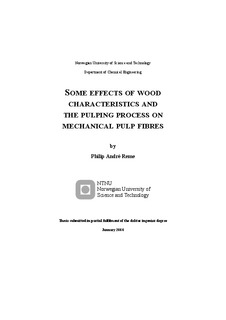| dc.contributor.author | Reme, Philip André | nb_NO |
| dc.date.accessioned | 2014-12-19T13:22:48Z | |
| dc.date.available | 2014-12-19T13:22:48Z | |
| dc.date.created | 2000-03-21 | nb_NO |
| dc.date.issued | 2000 | nb_NO |
| dc.identifier | 123085 | nb_NO |
| dc.identifier.isbn | 82-7984-042-7 | nb_NO |
| dc.identifier.uri | http://hdl.handle.net/11250/248066 | |
| dc.description.abstract | The thesis comprises three parts: Existing methods for characterisation of fibre crosssections have been improved, and new methods have been developed. These methods have then been applied to study the effects of wood characteristics and the pulping process on mechanical pulp fibres. Links have been established between fibre structure and paper properties such as surface smoothness and light scattering coefficient.
New methods, based on SEM-images and image analysis, are described for providing cross-sectional fibre dimensions for large fibre populations, for wood tracheids (app. 60 000 tracheids in a wood trunk) and for processed pulp fibres (app. 1000 fibres per sample). The methods are suited e.g. for evaluation of changes in the fibre cross-sections from wood to the finished paper, or for mapping of fibre parameters within and between growth rings in a wood trunk. The treatment of data is discussed, showing how one may examine the changes in different groups of fibres (earlywood fibres, latewood fibres, split fibres) throughout a process.
It is known from the literature that groundwood-based paper is superior to TMP-based paper with respect to printability. Fibres from SGW and PGW-pulp were found to be much more split in the longitudinal direction than TMP-fibres at comparable freeness. Intact groundwood fibres had thicker walls than intact TMP-fibres, but nevertheless super calendered hand sheets made from groundwood fibres were less roughened by moistening than were TMP-based sheets. Both for groundwood pulps and for TMPpulps, it was shown that reduced fibre wall thickness and increased fibre splitting was beneficial for improved surface smoothness and opacity.
Latewood defibrate easier than earlywood during refining. In the case of grinding, there was no particular preference for earlywood or latewood to be defibrated. Reject refining of groundwood reject was, however, found to be very important for defibration of latewood-containing shives. Pulps made from a raw material with more compact fibres (high wall area to lumen area ratio) were found to defibrate easier, and contain less shives. It was found that refining tends to reduce wall thickness most on thickwalled parts of the fibre, thus causing a reduction of the wall thickness variation around the perimeter.
Earlywood fibres were found to be preferentially split during refining. Most fibre splitting occurs during the primary stage, while the fibres are firmly attached to chips or fibre bundles. Latewood fibre wall thickness decreases considerably more than earlywood fibre wall thickness during refining. It seems that choosing an appropriate raw material is more effective than using excessive energy on reducing the wall thickness of thickwalled fibres. Earlywood fibres became more flattened during refining compared to latewood fibres, possibly due to repeated compressions and relaxations in the refiner.
The energy consumption to a given freeness was found to be considerably larger for Scots Pine than for Norway Spruce. However, the fibre transverse dimensions did not differ much between Norway Spruce and Scots Pine. Pine pulps were far less developed than spruce pulps at similar energy level. A possible explanation for the large energy consumption may be that redistribution of extractives at the fibre surface could reduce friction in the refiner. This hypothesis should be further explored.
The results in this study improve the knowledge of which fibre parameters that matter for surface smoothness and opacity of wood-containing publication paper. Further, this study elucidates how important fibre parameters such as wall thickness and fibre splitting are altered during a refining process. The results may be utilized to identify possible ways of modifying the TMP-process in order to produce paper with improved surface smoothness and opacity. | nb_NO |
| dc.language | eng | nb_NO |
| dc.publisher | Fakultet for naturvitenskap og teknologi | nb_NO |
| dc.relation.ispartofseries | Dr. ingeniøravhandling, 0809-103X; 2000:21 | nb_NO |
| dc.relation.haspart | Reme, Philip André; Johnsen, P.O.; Helle, T.. Assessment of fibre transverse dimensions using SEM and image analysis. JOURNAL OF PULP AND PAPER SCIENCE. 28(4): 122-128, 2002. | nb_NO |
| dc.relation.haspart | Reme, Philip André; Helle, T.. Assessment of transverse dimensions of wood tracheids using SEM and image analysis. Holz als Roh- und Werkstoff - The original publication is available at www.springerlink.com. 60(4): 277-282, 2002. | nb_NO |
| dc.relation.haspart | Reme, Philip André; Helle, T.; Johnsen, P.O.. Fibre characteristics of some mechanical pulp grades. NORDIC PULP & PAPER RESEARCH JOURNAL. 13(4): 263-28, 1998. | nb_NO |
| dc.relation.haspart | Reme, Philip André; Johnsen, P.O.; Helle, T.. Changes induced in early- and latewood fibres by mechanical pulp refining. NORDIC PULP & PAPER RESEARCH JOURNAL. 14(3): 256-262, 1999. | nb_NO |
| dc.relation.haspart | Reme, Philip André; Helle, T.. The fibre characteristics of shives initiating web rupture. NORDIC PULP & PAPER RESEARCH JOURNAL. 15(4): 287-291, 2000. | nb_NO |
| dc.relation.haspart | Reme, Philip André; Helle, T.. Quantitative assessment of mechanical fibre dimensions during defibration and fibre development. JOURNAL OF PULP AND PAPER SCIENCE. 27(1): 1-7, 2001. | nb_NO |
| dc.relation.haspart | Reme, Philip André; Helle, T.. On the difference in response to refining between Norway Spruce and Scots Pine. PAPERI JA PUU-PAPER AND TIMBER. 83(1): 58-61, 2001. | nb_NO |
| dc.title | Some effects of wood characteristics and the pulping process on mechanical pulp fibres | nb_NO |
| dc.type | Doctoral thesis | nb_NO |
| dc.source.pagenumber | 122 | nb_NO |
| dc.contributor.department | Norges teknisk-naturvitenskapelige universitet, Fakultet for naturvitenskap og teknologi, Institutt for kjemisk prosessteknologi | nb_NO |
| dc.description.degree | dr.ing. | nb_NO |
| dc.description.degree | dr.ing. | en_GB |
